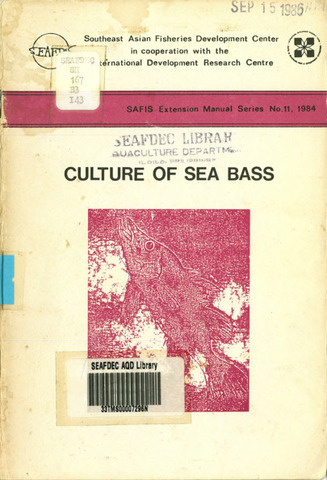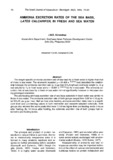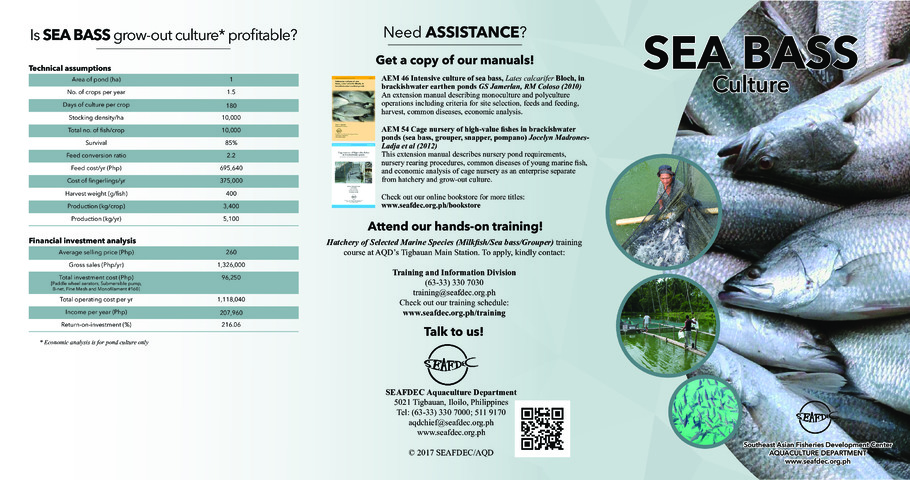Culture of sea bass
Share
Abstract
Sea bass or giant sea perch, known as pla kaphong, pla kaphong khao, or pla kaphong namjerd in Thailand, is one of the large brackishwater fish. The species is found mainly in estuaries and mangrove swamps adjacent to the sea. Sea bass is one of the economically important fishes, distributed widely along the coast in the Gulf of Thailand and the Andaman coast. It is also found in the Indo-Pacific and Australian regions.
Sea bass is an important local food fish because of its tasty and nutritious meat. It is an expensive fish compared with other species. Most sea bass sold in the market come from the natural watersheds. At present the supply is insufficient due to large demands. Since the marine capture fisheries have declined, coastal aquaculture has been fostered to compensate for the loss of fishery production from capture fisheries. Intensive promotion of sea bass culture can help to meet this objective.
Description
This paper is a translation of the Thai information and publication pamphlet entitled "Karn Liang Pla Kaphong Khao" (1978). It was translated by Mr. Vijai Srisuwantach, Senior Fisheries Biologist, National Inland Fisheries Institute, and further edited by the Secretariat.
Other versions
MalaySuggested Citation
Information and Publication Unit, Fishery Conservation and Extension Division, Department of Fisheries, Thailand. (1984). Culture of sea bass (V. Srisuwantach, Trans.). Bangkok, Thailand: Secretariat, Southeast Asian Fisheries Development Center.
Subject
sea bass culture  ; fish culture
; fish culture  ; site selection
; site selection  ; fry
; fry  ; seed collection
; seed collection  ; transport
; transport  ; nursery ponds
; nursery ponds  ; brackishwater aquaculture
; brackishwater aquaculture  ; pond culture
; pond culture  ; feeding
; feeding  ; cage culture
; cage culture  ; yields
; yields  ; mortality causes
; mortality causes  ; stocking density
; stocking density  ; live feeds
; live feeds  ; water quality
; water quality  ; manuals
; manuals  ; aquaculture
; aquaculture  ; Sea bass; Lates calcarifer; Thailand
; Sea bass; Lates calcarifer; Thailand
 ; fish culture
; fish culture  ; site selection
; site selection  ; fry
; fry  ; seed collection
; seed collection  ; transport
; transport  ; nursery ponds
; nursery ponds  ; brackishwater aquaculture
; brackishwater aquaculture  ; pond culture
; pond culture  ; feeding
; feeding  ; cage culture
; cage culture  ; yields
; yields  ; mortality causes
; mortality causes  ; stocking density
; stocking density  ; live feeds
; live feeds  ; water quality
; water quality  ; manuals
; manuals  ; aquaculture
; aquaculture  ; Sea bass; Lates calcarifer; Thailand
; Sea bass; Lates calcarifer; Thailand
Collections
Related items
Showing items related by title, author, creator and subject.
-
Ammonia excretion rates of the sea bass, Lates calcarifer, in fresh and sea water
Almendras, Jesus Manolo E. (Society of Israeli Aquaculture and Marine Biotechnology, 1994)The weight-specific ammonia excretion rate of sea bass (Lates calcarifer) fry in fresh water is higher than that of those in sea water. The allometric equation \(y = 24.426 \times ^{-0.4714}\) best describes the relationship ... -
Intensive culture of sea bass, Lates calcarifer Bloch, in brackishwater earthen ponds
Jamerlan, Gerry S.; Coloso, Relicardo M. (Aquaculture Department, Southeast Asian Fisheries Development Center, 2010)An extension manual describing criteria for site selection, monoculture and polyculture operations including feeds and feeding, harvest, common diseases, economic analysis. -
Sea bass culture
Southeast Asian Fisheries Development Center, Aquaculture Department (Aquaculture Department, Southeast Asian Fisheries Development Center, 2017)The brochure contains information on the culture of sea bass from the hatchery, nursery and grow-out phases.




